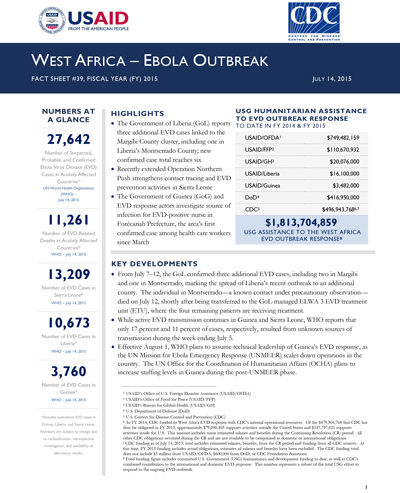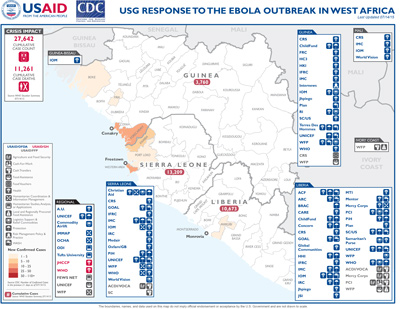Speeches Shim
August 14, 2015
HIGHLIGHTS
Ebola Response
Visit our main West Africa Ebola Outbreak page to learn more about how we're responding to the West Africa Ebola outbreak, and what you can do to help.
- No reported EVD cases for five consecutive days in Guinea reflect the longest period without a new EVD case since the start of the current outbreak
- Interim analysis finds EVD vaccine highly effective
- USAID/FFP assistance increases access to food for vulnerable households in EVD-affected districts of Sierra Leone
West Africa - Ebola Outbreak Fact Sheet #43 (FY 15) ![]() (pdf - 377k)
(pdf - 377k)
KEY DEVELOPMENTS
- The UN Mission for Ebola Emergency Response (UNMEER) officially closed on July 31; the UN World Health Organization (WHO) is now responsible for oversight of the UN system’s Ebola virus disease (EVD) emergency response. The UNMEER Ebola crisis managers will remain in the EVD-affected countries under the oversight of WHO and with the support of the UN resident coordinators and UN country teams. According to UNMEER, the mission was established on September 19, 2014, as a temporary measure to meet immediate needs related to the EVD outbreak, deploying financial, logistical, and human resources to Guinea, Liberia, and Sierra Leone.
- The clinical trial for the Vesicular Stomatitis Virus-Ebola Virus vaccine in Guinea is expanding to be offered to all EVD contacts. WHO experts continue to underscore that, while indicating positive and promising efficacy rates, the recently published interim results of the trial are not fully conclusive.
REGIONAL
During the week of August 3–9, the number of new confirmed EVD cases in EVD-affected West African countries remained at three, according to WHO. Guinea recorded two confirmed EVD cases in two prefectures, and Sierra Leone reported one confirmed EVD case in one district. Liberia maintained zero confirmed EVD cases during the same period, and WHO reported that all contacts related to the last EVD cluster completed their 21-day follow-up period. No health care worker infections occurred for the second consecutive week in any of the EVD-affected countries.
West Africa Ebola Map #43 August 14, 2015 ![]() (pdf - 534k)
(pdf - 534k)
Liberia
USAID/OFDA continues to support the coordination and rollout of the Government of Liberia (GoL) Safe and Quality Services (SQS) training to health care personnel in Liberia’s 15 counties. The SQS training, a revised GoL infection prevention and control (IPC) curriculum, aims to prevent the spread of EVD and other communicable diseases through implementing standard, risk-based IPC precautions, IPC principles during emergency clinical management, facility-based disease surveillance, and psychosocial support training.
During the week of August 3, the GoL Ministry of Health (MoH), CDC, and WHO launched the national SQS training package for 70 master trainers—including staff from nine USAID/OFDA partner organizations—in Liberia’s capital city of Monrovia. Beginning August 17, the master trainers will deploy countrywide to train county-level trainers who, in turn, plan to train Liberia’s estimated 9,000 health care workers by the end of 2015.
EVD response actors continue to provide mentoring for and supervision of IPC protocols within Liberia’s health care facilities. USAID/OFDA partner John Snow, Inc. (JSI) recently conducted IPC supervision at 17 sites in Gbarpolu, Grand Kru, Montserrado, River Cess, River Gee, and Sinoe counties. In addition, JSI established IPC committees to monitor protocols at four health care facilities in Grand Kru.
Sierra Leone
The Government of Sierra Leone Ministry of Health and Sanitation reported one new confirmed EVD case between August 3 and 9. The EVD case, identified in Western Urban District, is an eight-month-old child not on a contact list; however, case investigators have identified a connection between the child’s mother and a prior EVD case in Western Urban. As of August 14, case investigators had identified 43 contacts—including 29 high-risk individuals—in connection to the case, according to the National Ebola Response Center (NERC). Case investigators are attempting to locate additional contacts, some of whom are high-risk.
In Tonkolili District, more than 600 people remain under quarantine connected to the district’s two late July and early August EVD cases—the first in more than 150 days. The Tonkolili District Ebola Response Center (DERC) reported plans to discharge all quarantined individuals by August 22, provided no additional EVD cases develop.
The USG Disaster Assistance Response Team (DART) deputy leader in Sierra Leone joined principal representatives from the NERC, donor countries, and UN agencies on a trip to Tonkolili on August 8 to assess EVD response operations in the district. The group attended a meeting of the Tonkolili DERC, which provided an overview of the current situation and updates on case management and social mobilization efforts, psychosocial services, safe and dignified burials, and EVD-related security activities in the district. DERC leadership also presented a response plan to address the re-emergence of EVD in the district and requested additional resources from the NERC to implement the plan over a 90-day period.
In late July, USAID/FFP provided nearly $3.6 million to World Vision in Sierra Leone to support the provision of cash transfers for food purchases to more than 32,000 people directly or indirectly affected by EVD in Port Loko District. World Vision is also providing agricultural input vouchers and training to nearly 3,400 farmers for the next cropping season to promote recovery of the agricultural sector. The project aims to increase the most vulnerable households’ access to food, stimulate local markets, and support the recovery of agricultural production systems in Port Loko.
USAID/FFP also recently provided nearly $2.8 million to CARE in Sierra Leone to increase EVD-affected households’ access to food and support local market recovery in EVD-impacted chiefdoms of Bombali and Tonkolili districts. CARE plans to provide cash transfers to 27,000 households to meet their basic food needs during the lean season.
Guinea
The Government of Guinea (GoG) reported two new EVD cases for the week of August 3–9. On August 3, local authorities identified one confirmed EVD case in Conakry Prefecture’s Ratoma sub-prefecture, and a post-mortem swab on August 4 confirmed the second EVD case in Moussayah sub-prefecture in Forécariah Prefecture. Prefectural authorities did not confirm any new EVD-positive cases for five consecutive days between August 5 and 9—the longest period without a new EVD case in Guinea since the start of the current outbreak, according to the National Ebola Coordination Cell.
The GoG reported a total of seven new confirmed EVD cases from Conakry, Coyah, and Forécariah prefectures during the 21-day period ending August 9. In addition, Kindia Prefecture remained on alert, indicating the presence of contacts in the prefecture who had not yet graduated from a 21-day monitoring period. As of August 9, 13 EVD patients—seven confirmed and six suspected cases—were seeking treatment in four EVD treatment units (ETUs) countrywide, including eight patients at Conakry’s Nongo ETU, two each at the Boké and Forécariah ETUs, and one at the Coyah ETU.
GoG health officials recently expressed concern regarding the increased number of contacts identified as missing, or perdu de vue (PDV), following 72 hours of consecutive absence, particularly from EVD hotspot areas. The National Ebola Coordination Cell reported that 21 high-risk PDVs from the past 21 days remained to be found as of August 9, representing a more than 133 percent increase from nine such high-risk PDVs as of August 4. In total, 63 PDVs remained missing as of August 9, including 20 high-risk PDVs in Conakry—an increase from 45 PDVs reported as of August 6. Challenges to locating PDVs include false contact information and evasion of case investigators and surveillance teams. While GoG authorities and contact tracers continue to search for missing and unknown contacts, the National Ebola Coordination Cell is forming a working group to improve PDV-finding strategies—such as collaboration with local leaders and utilizing culturally appropriate EVD-related messaging, among other initiatives—and reduce community reticence and the risk of continued EVD transmission.
PUBLIC DONATION INFORMATION
- The most effective way people can assist relief efforts is by making cash contributions to humanitarian organizations that are conducting relief operations. A list of humanitarian organizations that are accepting cash donations for disaster responses around the world can be found at www.interaction.org.
- USAID encourages cash donations because they allow aid professionals to procure the exact items needed (often in the affected region); reduce the burden on scarce resources (such as transportation routes, staff time, and warehouse space); can be transferred very quickly and without transportation costs; support the economy of the disaster-stricken region; and ensure culturally, dietary, and environmentally appropriate assistance.
More information can be found at:
- The Center for International Disaster Information: www.cidi.org or +1.202.821.1999.
- Information on relief activities of the humanitarian community can be found at www.reliefweb.int.
USAID/OFDA bulletins appear on the USAID website at what-we-



Comment
Make a general inquiry or suggest an improvement.